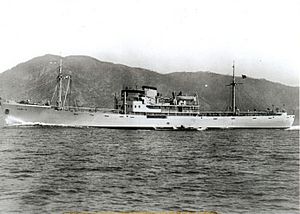Italian auxiliary cruiser Ramb III facts for kids
 |
|
Quick facts for kids History |
|
|---|---|
| Name | Ramb III |
| Builder | Ansaldo, Genoa |
| Launched | 6 March 1938 Banana boat |
| Commissioned | 1940 |
| Reclassified | Convoy escort, 1940 |
| Homeport | Massawa, Eritrea |
| Fate | Seized by Germany, 9 September 1943 |
| Name | Kiebitz |
| Reclassified | Minelayer |
| Fate | Sunk in Rijeka harbor, November 1944 |
| Name | Galeb |
| Acquired | Refloated, post-war |
| Decommissioned | 1992 |
| Reclassified | Training ship and presidential yacht, 1952 |
| Status | Museum ship |
| General characteristics | |
| Type | Auxiliary cruiser |
| Displacement | 3,667 long tons (3,726 t) |
| Speed | 18.5 knots (21.3 mph; 34.3 km/h) |
| Armament |
|
The Ramb III was an Italian ship with a long and interesting history. It was built in Genoa, Italy, in 1938. This ship changed its purpose and even its name many times over the years. It started as a "banana boat" and later became a warship and a presidential yacht.
Ramb III was one of four similar ships. They were all designed to be "banana boats". This meant they would carry refrigerated bananas from places like Somaliland and Eritrea in Italian East Africa to Europe. The company that owned them was called the Royal Banana Monopoly Business. Even though it was a cargo ship, Ramb III was built so it could be changed into a warship if needed. It weighed 3,667 tons and could travel at 18.5 knots (about 21 miles per hour).
Contents
Ramb III as a Convoy Escort
When Italy entered World War II in June 1940, Ramb III was still in Italian waters. The Italian Royal Navy took control of the ship. They turned it into a convoy escort. A convoy escort is a warship that protects groups of merchant ships from enemy attacks.
Like its sister ships, Ramb III was given weapons. It had two large 120 mm (4.7-inch) guns. It also had eight 13.2 mm anti-aircraft guns to shoot down enemy planes.
Battle in the Adriatic Sea
On November 12, 1940, British warships attacked the Italian port of Taranto. At the same time, some British cruisers and destroyers sailed into the Adriatic Sea. They found a small group of four Italian merchant ships. Ramb III and another ship called Fabrizi were protecting them.
The ships were traveling from Vlorë to Brindisi. Ramb III fired its guns 19 times to defend itself. It managed to escape without any damage. The Fabrizi stayed and fought the British ships. It was hit and badly damaged. After the Fabrizi was disabled, the British sank all four Italian merchant ships. This battle happened near the Strait of Otranto.
During the winter of 1940–1941, Ramb III continued to protect convoys. It carried refrigerated or general cargo to places like the Dodecanese islands and North Africa.
Torpedo Attack in Benghazi
On May 10, 1941, a British submarine called HMS Triumph attacked Ramb III. The submarine fired a torpedo at the ship in Benghazi harbor. Ramb III was hit. The Italians managed to save the ship. They towed it all the way back to Trieste for repairs.
Kiebitz: A German Minelayer
On September 9, 1943, German troops took control of Ramb III in Trieste. The ship was then used by the German navy, called the Kriegsmarine. They changed its name to Kiebitz.
The Germans refitted Kiebitz to become a minelayer. A minelayer is a ship that places naval mines in the water. These mines explode when other ships hit them. Kiebitz laid over 5,000 mines in the Adriatic Sea.
One day, Kiebitz accidentally hit one of its own mines near Ancona. It was damaged but managed to reach Rijeka. In November 1944, Allied aircraft attacked Kiebitz in Rijeka harbor. The ship was sunk.
Galeb: A Training Ship and Presidential Yacht
After World War II ended, the sunken Kiebitz was brought back to the surface. This was done by a company called Brodospas. In 1952, the ship was rebuilt in Pula. It was given a new name, Galeb (which means "seagull").
Galeb became a training ship for the Yugoslav navy. Later, it became the special yacht for President Josip Broz Tito of Yugoslavia. The ship's look changed a lot from its days as Ramb III. Galeb served for 40 years in this role. Today, the Galeb is a museum ship in the Port of Rijeka. You can visit it there.

